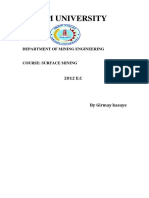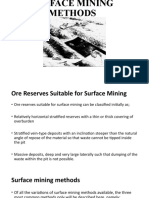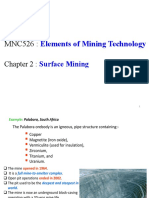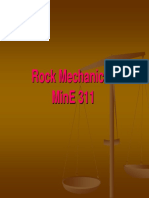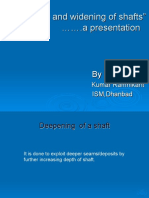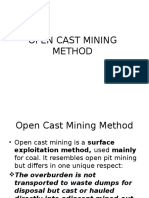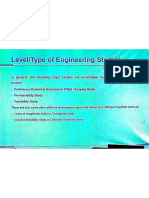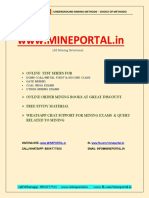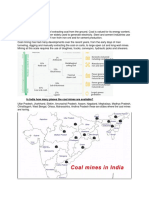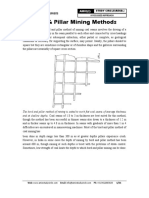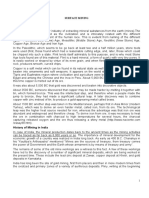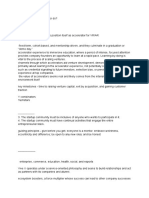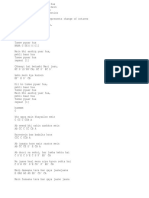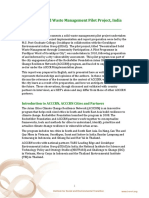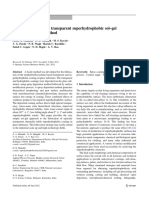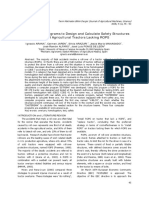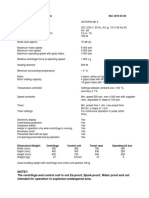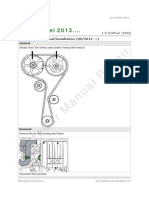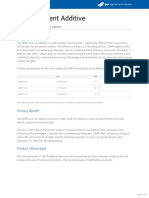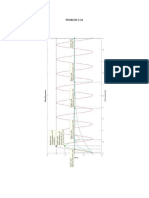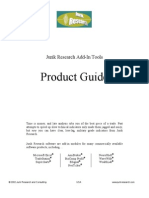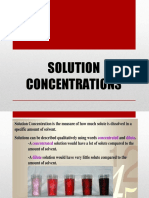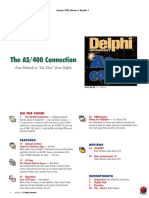Cross-section of a mineral deposit
Methods of Mining
The essence of mining in extracting mineral wealth
from the earth is to drive an excavation or
excavations from the surface to the mineral deposit.
Normally, these openings into the earth are meant to
allow personnel to enter into the underground
deposit.
If the excavation used for mining is entirely open or
operated from the surface, it is termed a surface
mine.
If the excavation consists of openings for human
entry below the earths surface, it is called an
underground mine.
The mining method selected for exploitation is determined
mainly by the characteristics of the mineral deposit and the
limits imposed by safety, technology,environmental
concerns,and economics.
Geologic conditions, such as the dip,shape, and strength of the
ore and the surrounding rock,play a key role in selecting the
method.
Traditional exploitation methods fall into two broad categories
based on locale: surface or underground.
Surface mining includes mechanical excavation methods such
as open pit and open cast (strip mining),and aqueous methods
such as placer and solution mining.
Underground mining is usually classified in three categories of
methods: unsupported, supported,and caving.
�Mining Methods
Coal is mined by two main methods surface or
opencast mining and underground mining.
The choice of method is largely determined by:
the depth, geology of the coal deposit and
other factors.
The majority of the world's coal production is
coming from Opencast mines.
This scenario is same in India also.
� The simple aim in selecting and implementing
a particular mine plan is always to mine a
mineral deposit so that profit is maximised
given the unique characteristics of the deposit
and its location, current market prices for the
mined mineral, and the limits imposed by
safety, economy, environment
�The choice of mining method depends on many factors,
including:
(i)Shape of the orebody: tabular, cylindrical, spherical.
(ii)Orientation of the orebody: sub-horizontal, sub-vertical.
(iii)Continuity of the orebody.
(iv)Ore-grade: high-grade, low-grade.
(v)Distribution of ore-bearing minerals within the orebody: massive or
disseminated (with a cut-off grade).
(vi)Depth to the orebody.
(vii)Strength of the orebody and overburden/host-rocks rocks
(viii)Area of land available for waste disposal open-pit mines
cover a larger surface area and generate a greater volume of wastes.
(ix)Impacts on surface: environmental, surface drainage and sub-surface
aquifers, land-use changes, social.
(x)Rehabilitation concerns.
(xi)Projected production rates.
(xii)Capital costs, rate of (financial recovery), cash-flow
(xiii)Safety concerns surface mining methods have a better
safety record.
Simple in concept, highly
engineered for efficiency. Very
high waste rock volume.
Better safety record.
Used for laterally extensive
deposits. Overburden cast
directly back into mined out
panels. Rehabilitation keeps
pace with mining.
Reduced waste rock
production. Poor safety
record. Used for soluble ores:
uranium, salt, potash.
Minimal waste production:
only water wastes, no solids.
� Surface mines can be subdivided into various
subclasses and which can be illustrated as
follows:
�Surface mining
is a type of mining in which soil and rock
overlying the mineral deposit (the overburden)
are removed.
Surface mining is used when deposits of
commercially useful minerals or rock are found
near the surface; that is, where the overburden
is relatively thin or the material of interest is
structurally unsuitable for tunneling (as would
usually be the case for sand, and gravel (.
� Surface mining requires large capital
investment (primarily expensive
transportation equipment), but generally
results in:
High productivity (i.e., high output rate of ore)
Low operating costs
Safer working conditions and a better safety
record than underground mining
� In most forms of surface mining, heavy equipment, such
as earthmovers such as dragline excavators first
remove the overburden. Next, huge machines like
shovels or Bucket wheel excavators, extract the mineral.
Where minerals occur deep below the surface or where
the overburden is thick or the mineral occurs as veins in
hard rock, underground mining methods are used to
extract the valued material.
Surface mines are typically enlarged until either the
mineral deposit is exhausted, or the cost of removing
larger volumes of overburden makes further mining no
longer economically viable.
� In open-pit mining a Stripping Ratio refers to
the amount of waste rock removed to recover
ore. For example, a stripping ratio of 3:1
means to recover one ton of ore you must
remove three tons of waste rock.
A large Stripping Ratio is less economical
efficient than a small one, because that means
more rock will need to be moved without
generating revenue. If The ratio is going to be
too large, then underground mining will usually
be more efficient.
� Ore reserves suitable for surface mining can be
classified initially as;
1. Relatively horizontal stratified reserves with a thin or
thick covering of overburden
2. Stratified vein-type deposits with an inclination
steeper than the natural angle of repose of the
material so that waste cannot be tipped inside the pit
3. Massive deposits, deep and very large laterally such
that dumping of the waste within the pit is not
possible.
Open-pit mines are dug on benches, which describe vertical
levels of the hole. These benches are usually on four meter to
sixty meter intervals, depending on the size of the machinery
that is being used. Many quarries do not use benches, as they
are usually shallow.
Most walls of the pit are generally dug on an angle less than
vertical, to prevent and minimize damage and danger from rock
falls. This depends on how weathered the rocks are, and the
type of rock, and also how many structural weaknesses occur
within the rocks, such as a fault, shears, joints or foliations.
The walls are stepped. The inclined section of the wall is known
as the batter, and the flat part of the step is known as the bench
or berm.
� A haul road is usually situated at the side of
the pit, forming a ramp up which trucks can
drive, carrying ore and waste rock.
Waste rock is piled up at the surface, near the
edge of the open pit. This is known as the
waste dump. The waste dump is also tiered
and stepped, to minimize degradation.
Ore which has been processed is known as
tailings, and is generally a slurry. This is
pumped to a tailings dam or settling pond,
where the water evaporates.
�Basics of an open pit mine
��� A bench may be defined as a ledge that forms a single
level of operation above which mineral or waste
materials are mined back to a bench face. The mineral
or waste is removed in successive layers, each of which
is a bench. Several benches may be in operation
simultaneously in different parts of, and at different
elevations in the open pit mine.
Bench parameters (geometry):
a. height
b. width
c. slope angle
� BENCHHEIGHT: Vertical distance between
the highest point on the bench (crest) and the
lowest point or the bench (toe). It is
influenced by size of the equipment, mining
selectivity, government regulations and safety.
BENCH SLOPE or BANK ANGLE:
Horizontal angle of the line connecting bench
toe to the bench crest.
� BERM: Horizontal shelf or ledge within the
ultimate pitwall slope left to enhance the
stability of the slope within the pit and
improve the safety. Berm interval, berm width
and berm slope angle are determined by the
geotechnical investigation.
�Bench Design
I n d i v i d u a l b e n c h e s a re d e s i g n e d t o
accommodate the materials-handling
equipment utilized. The height is limited by the
reach of the excavators; a power shovel can
trim a higher bank than a front-end loader or
hydraulic excavator.
The width must be sufficient to contain most
of the fly rock from a bench blast and provide
enough maneuvering room for excavator and
haulage units.
The slope is the maximum dictated by rock or
soil mechanics concerns.
�factors to be considered for deciding
bench height
Thickness of Overburden and mineral deposit
Equipment available and their limiting capacity
Strength of the rock and presence of
geological disturbances
Presence of water
�Pit Design: Benches
Higher and wider benches yield :
1. Less selectivity (dilution, recovery)
2. Fewer working places thus less flexibility
3. Flatter slopes: large machines need wide
benches
4. Fewer equipment relocations & set-ups
5. Higher productivity at lower unit cost
6. Improved control and supervision
�How High Should a Bench Be ?
1. Deposit character and geology: selectivity
2. Production strategy: ore/waste ratios,
blending requirements, no. of working faces,
operating/capital costs, etc.
3. Slope stability considerations
4. Equipment set / equipment specific
optimum geometry
�Reduced Bench Heights
Advantages
1. ramp volume reduced (fill ramps)
2. contour areas easier to drill & blast
3. ore grading and selective mining is easier
4. multi-row blasts easier to blast
5. single pass drilling easier
Disadvantages
1. poor bench grade control by shovel is accentuated
2. reduced drilling yield and increased drill and blast
cost
3. sub grade costs more (relatively larger)
4. reduced shovel productivity
�Slope Design:
1. Maximize the height of the benches
* at the expense of mining selectivity?
2. Minimize the width of working benches
* at the expense of productivity?
3. Minimize the number & width of catch
benches
* at the expense of safety?
4. Minimize the width & number of haul roads
* at the expense of productivity & safety?
�Various open-pit and orebody
configurations
Flat lying seam or bed,
flat terrain. Example
platinum reefs, coal.
Massive deposit, flat
terrain. Example ironore or sulphide
deposits.
Dipping seam or bed,
flat terrain. Example
anthracite.
�Various open-pit and orebody
configurations
Massive deposit, high
relief. Example copper
sulphide.
Thick bedded deposits,
little overburden, flat
terrain. Example iron
ore, coal.
�Open-pit Mining
This is the traditional cone-shaped excavation
(although it can be any shape, depending on the size
and shape of the orebody) that is used when the ore
body is typically pipe-shaped, vein-type, steeply
dipping stratified or irregular. Although it is most often
associated with metallic orebodies.
The excavation is normally by rope- or hydraulic
shovels with trucks carrying both ore and waste. Drill
and blast is most often used, which makes the
process cyclic. Waste is dumped outside the minedout area since no room is available within the pit.
Waste is placed as close to the edge of the pit as
possible, to minimise transport costs.
� In open-pit mining a Stripping Ratio refers to
the amount of waste rock removed to recover
ore. For example, a stripping ratio of 3:1
means to recover one ton of ore you must
remove three tons of waste rock.
A large Stripping Ratio is less economical
efficient than a small one, because that means
more rock will need to be moved without
generating revenue. If The ratio is going to be
too large, then underground mining will usually
be more efficient.
�� Benches are normally excavated from 2-15m in height in
stacks of 3 to 4, in between which is a crest on which the
haul road is placed.
When the number of benches in the stack increases, the
road gradient increases too.
Benches in the stack have a steep face angle whilst the
stack and overall slope angles are flatter, thereby helping
to prevent slope failures.
From an analysis of overall slope geometry, it is clear that
as steep a slope as possible should be mined, to reduce
the overall stripping ratio. However, this rule is limited by
the maximum gradient of the haul road typically 8-10%
which requires frequent wider crests, and the need to have
flatter slope angles in places to provide slope stability.
Note that each pit slope can have a different angle
according to the requirements of the design with or
without haul road, geology, etc
� Mineral and especially waste transport costs
comprise the greatest amount of an open-pit
mines working costs. To reduce this cost
aspect especially when the pit gets deeper,
the following options are possible;
! In-pit crushers together with a conveyor
belt, instead of truck transport.
! Trolley-assist on the main haul road.
(electrical power supply to trucks) faster
trucks, steeper roads
! Computerised truck dispatch more
efficient use of trucks
! Steeper bench slope angles (in other
words, a reduced stripping ratio) where
stability allows them especially at the
bottom of the pit when LOM approaches end.
�� As a result of the high cost of rock transport
up to 50% of an open-pits total operating
costs, many large pits consider continuous
transport systems.
Continuous transport systems (and the
associated in-pit crusher if drill and blast is
used) begin to out-perform truck based
systems since they are run on electricity,
not diesel fuel.
�UNIT OPERATIONS OF MINING
During the development and exploitation stages of
mining when natural materials are extracted from the
earth, remarkably similar unit operations are normally
employed.
The unit operations of mining are the basic steps
used to produce mineral from the deposit,and the
auxiliary operations that are used to support them.
The steps contributing directly to mineral extraction
are production operations,which constitute the
production cycle of operations.
The ancillary steps that support the production cycle
are termed auxiliary operations.
� The production cycle employs unit operations
that are normally grouped into rock breakage
and materials handling.
Breakage generally consists of drilling and
blasting, and materials handling
encompasses loading or excavation and
haulage (horizontal transport) and sometimes
hoisting (vertical or inclined transport).
Thus,the basic production cycle consists of
these unit operations:
Production cycle= drill + blast + load + haul
� Drilling is the process of making a hole into a hard surface
for placement of explosives for blasting. The objective of
drilling and blasting is to prepare well-fragmented loose
rock amenable to excavation so that it can be easily
handled by the loading, transporation and other machinery
deployed for overburden removal and mineral extraction.
Drilling and Blasting is the important ground preparation
job. Unless the rock mass is highly weathered and very
much unconsolidated drilling of holes for placement of
explosives and detonating them for blasting is required for
any mining operation.
Modern machines like continuous surface miner and
Bucket wheel Excavators can however eliminate the need
of drilling and blasting in certain surface mining operations.
� In modern surface mining,blastholes of 3 to 15 in.
(75 to 380 mm) in diameter are produced by rotary
or percussion drills for the placement of explosives
when consolidated rock must be removed.
The explosive charge is then inserted and detonated
to reduce the overburden or ore to a size range
suitable for excavation. The broken material is
loaded by shovel,dragline,or wheel loader into
haulage unitsgenerally trucksfor transport.
Railroad cars are also used for haulage,and belt
conveyors are often used after the material is
crushed.
�Mining Process (Opencast)
�Open-cast or strip mining
Used for near-surface, laterally continuous,
bedded deposits such as coal, stratified ores
such as iron ore, and surficial deposits (nickel
laterite or bauxite).
The pits are shallower that open-pit mines,
and the overburden is casted directly into
adjacent mined out panels.
It is a very low-cost, high-productivity method
of mining.
Opencast mining is ideally applied where the surface of the
ground and the ore body itself are relatively horizontal and not
too deep under the surface, and a wide area is available to be
mined in a series of strips.
Favourable conditions are:
Relatively thin overburden (0-50m maximum other wise stripping
ration and cost of stripping becomes too high)
Regular and constant surface topography and coal layers (not
more than 20 variation from horizontal on the coal seam
topography can vary more since pre-stripping can be used to
level it but this is expensive to apply)
Extensive area of reserves (to give adequate life of mine (LOM)
�Opencast Mining Technique
Walking draglines are for many years the most
popular machine for this type of mining due to their
flexibility, utility and availability, but more importantly,
their low operating costs for waste mining (R/t or R/
BCM).
The dragline is a typical combined cyclic excavator
and material carrier since it both excavates material
and dumps it without the use of trucks or conveyor
belts.
The dragline sits above the waste or overburden
block, usually 50m or so wide, on the highwall side
and excavates the material in front of itself, to dump it
on the low-wall or spoil side of the strip to uncover the
coal seam below it.
� Auger mining refers to a method for recovering coal
from thin seams, 2 to 8 ft (0.6 to 2.4 m) thick, beyond
a highwall produced by conventional open cast or
strip mining (area mining or contour mining), or from
seams accessed by deep trenches.
Coal is produced by boring openings into the seam
beneath the overburden.
It is used primarily where conventional surface or
underground methods are not economically or
technically feasible.
Often this is the only means available for recovering
coal that would otherwise be lost
� An auger typically consists of three
components: (1) cutterhead, (2) auger
flight(s), and (3) prime mover.
They are mechanically connected and
function as an integral power train.
The cutterhead is a barrel-shaped device that
cuts and fractures the coal.
The auger flight is a spiral wound about a drill
stem, forming a screw conveyor that serves
to transport the coal to the surface.
�Solution mining:
In-situ
Leaching
or
Borehole
Mining:
In-situ leaching (ISL), also known as in-situ recovery (ISR) or
solution mining, is a method of recovering minerals like copper
and uranium throughout boreholes drilled into the deposit. The
process primarily involves drilling of holes into the ore deposit.
Explosive or hydraulic fracturing may be used to create open
pathways in the deposit for solution to penetrate. Leaching
solution is pumped into the deposit where it makes contact with
the ore. The solution bearing the liquefied ore content is then
pumped to the layer and processed. This process permits the
extraction of metals and salts from an ore body without the
requirement for conventional mining entailing drill-and-blast,
open-cut or underground mining.
Used most commonly on evaporite (e.g. salt and potash) and
sediment-hosted uranium deposits, and also to a far lesser
extent to recover copper from low-grade oxidised ore.
� In-situ leach mining entails pumping of a leachate
solution into the ore body via a borehole, which
circulates via the porous rock dissolving the ore and
is extracted by means of a second borehole.
The leachate solution differs according to the ore
deposit - for salt deposits the leachate may be fresh
water into which salts may willingly dissolve. For
copper, acids are generally required to improve
solubility of the ore minerals within the solution. For
uranium ores, the leachate might be acid or sodium
bicarbonate.
� Evaporite deposits
Has been used for many decades to extract soluble
evaporite salts such as halite (NaCl), trona (3Na2O
4CO2), nahcolite (NaHCO3), epsomite (MgSO4
7H2O), carnallite (KMgCl3 6H2O), borax (Na2B4O7
10H2O) from buried evaporite deposits in UK, Russia,
Germany, Turkey, Thailand and USA).
A low salinity fluid, either heated or not, is injected
underground directly into the evaporite layer; the
pregnant solutions (brines) are withdrawn from
recovery boreholes and are pumped into evaporation
ponds, to allow the salts to crystallise out as the water
evaporates.
� Uranium deposits
Uranium minerals are soluble in acidic or
alkaline solutions.
The production (pregnant) fluid
consisting of the water soluble uranyl
oxyanion (UO22+) is subject to further
processing on surface to precipitate the
concentrated mineral product U3O8or
UO3(yellowcake).
��Leaching
Heap Leaching: Heap leaching is an industrial
mining method to dig out precious metals and
copper compounds from ore heaps.
The mined ore is crushed into tiny chunks and
heaped on an impermeable plastic and/or clay lined
leach pad where it may be irrigated with a leach
solution to melt the valuable metals. Sprinklers, or
frequently drip irrigation, are used to minimize
evaporation.
The solution then percolates through the heap and
leaches out the precious metal. This can take many
weeks. The leach solution having the dissolved
metals is then accumulated.
�Placer Mining
Placer mining is the mining of alluvial
sediments for minerals.
The name comes from Spanish, placera,
meaning "alluvial sand." It means that mining
the precious metal deposits (mainly gold and
gemstones) found in alluvial deposits
sediments of sand and gravel in modern or
very old stream beds.
�Hydraulic mining:
Hydraulic mining, or hydraulicking, is a type of
mining that uses water to displace rock
material or move deposit.
Generally used for weakly cemented nearsurface ore deposits.
The current form of hydraulicking, using jets
of water directed under very elevated
pressure via hoses and nozzles
�Dredging:
Used most often for mineral-sands and some
near-shore alluvial diamond mining
operations
Dredging" is a method often used to bring up
underwater mineral deposits. Although
dredging is usually employed to clear or
enlarge waterways for boats, it can also
recover significant amounts of underwater
minerals relatively efficiently and cheaply.
�Comparison of Deposit Conditions
Favorable to Surface Methods
